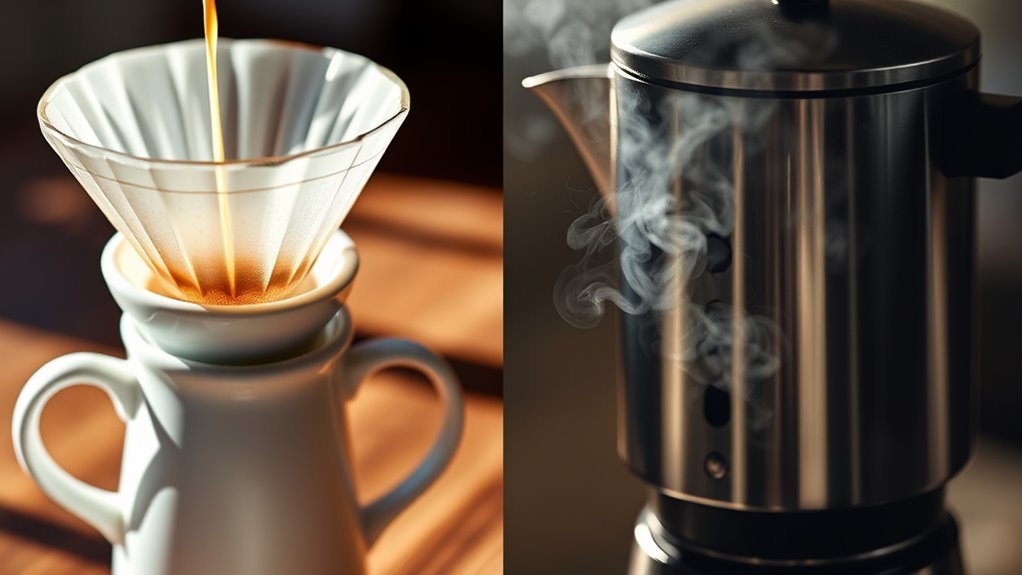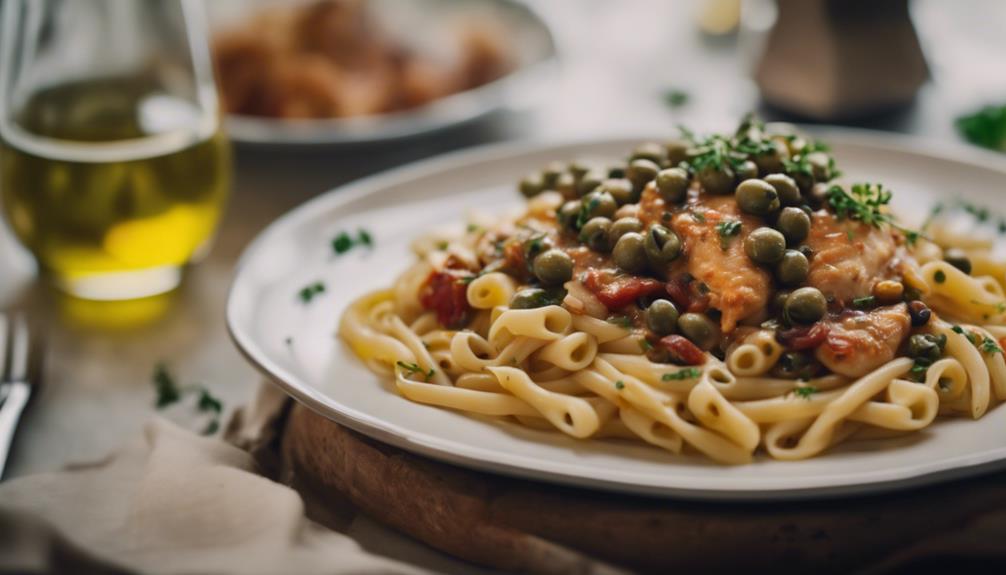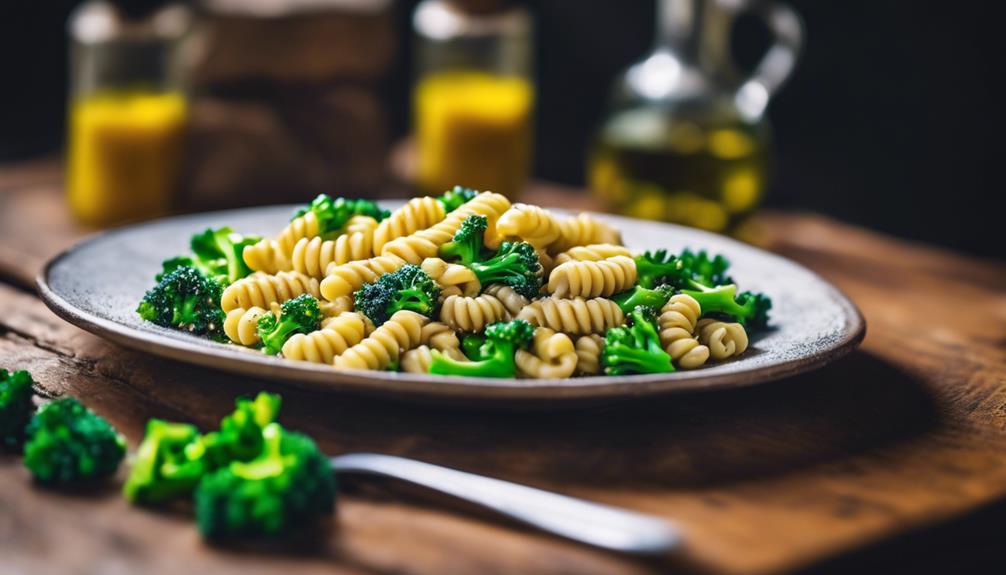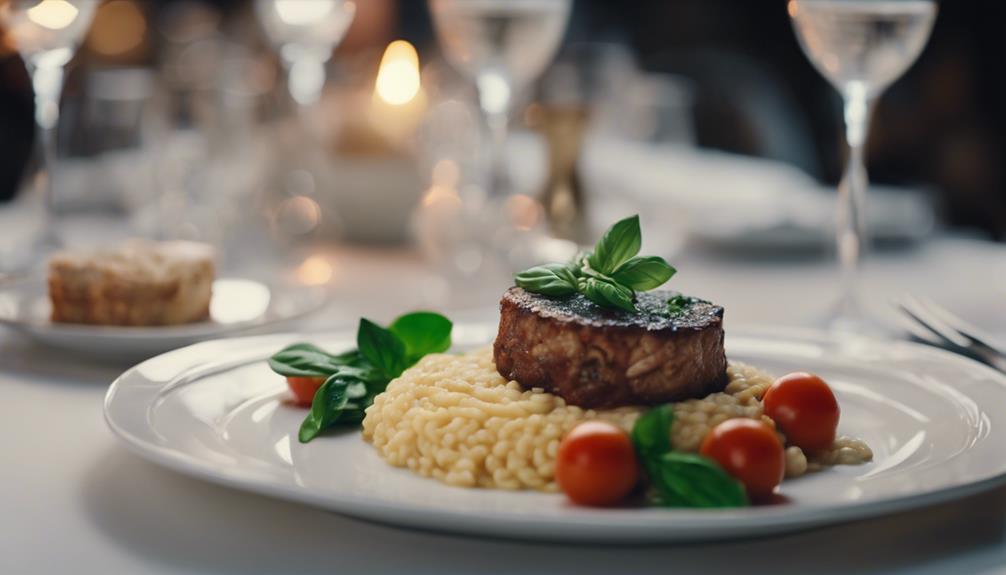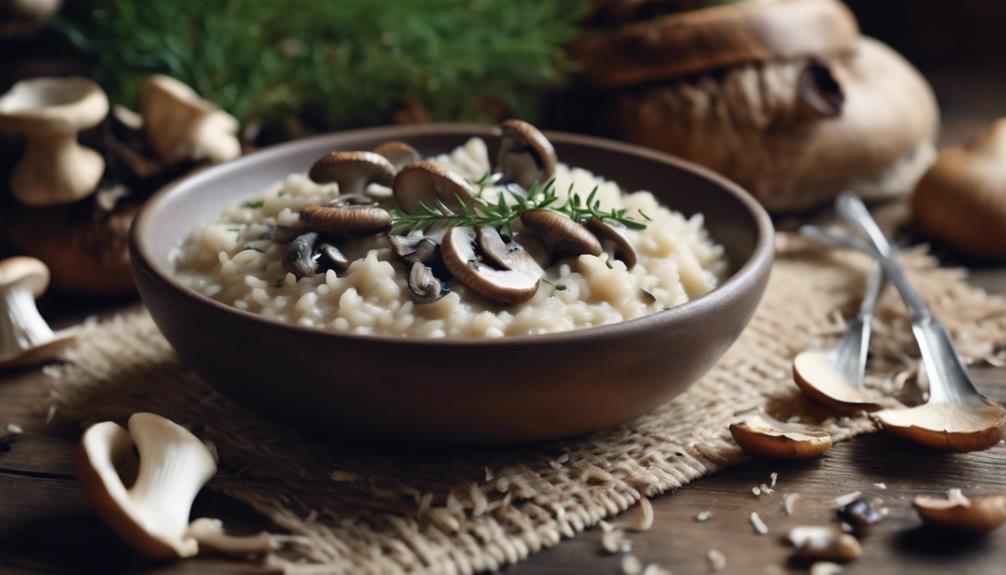To set yourself up for coffee brewing success, understand that immersion involves fully submerging grounds for a full-bodied flavor, while percolation passes hot water through grounds for a cleaner taste. Start with the right equipment, like a French press or pour-over cone, and control variables such as grind size and water temp. Experimenting with both methods helps you find your preferred flavor profile. If you keep exploring, you’ll discover tips that make your first brew truly satisfying.
Key Takeaways
- Ensure water temperature stays between 195°F and 205°F for optimal extraction in both methods.
- Use consistent grind size: medium for immersion, slightly coarser for percolation.
- Choose the right brewing vessel: French press for immersion, pour-over cone or percolator for percolation.
- Measure coffee grounds accurately and adjust contact time to control strength and flavor.
- Maintain cleanliness and quality water to prevent off-flavors and ensure successful brewing results.
Understanding Immersion Brewing: Basics and Benefits
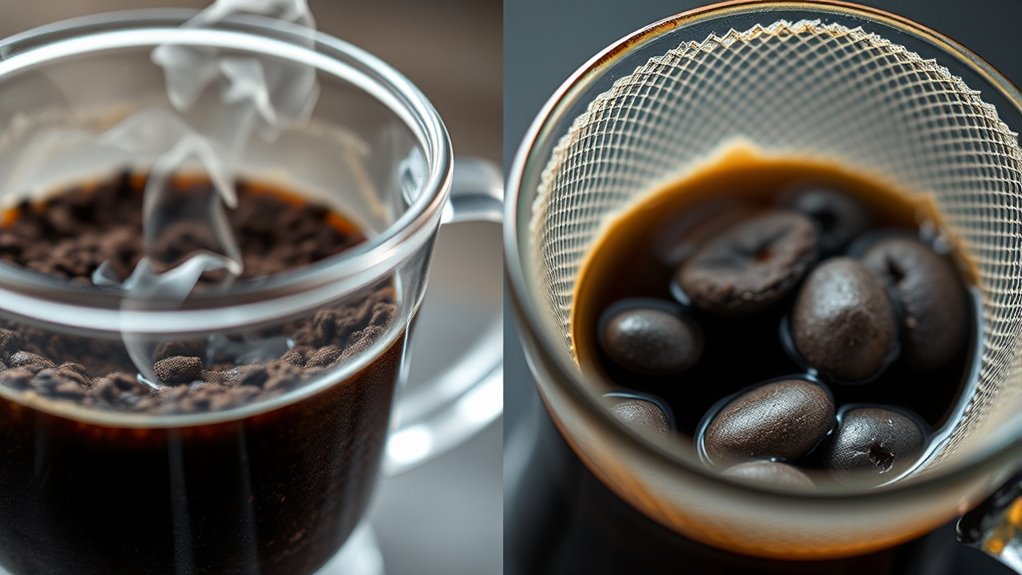
Immersion brewing is a straightforward method where coffee grounds are fully submerged in water during the brewing process. Your choice of coffee bean selection greatly impacts the flavor, with options ranging from light to dark roasts, each offering distinct profiles. To guarantee ideal extraction, water temperature plays a vital role—aim for around 195°F to 205°F, just below boiling. This range helps extract balanced flavors without over-extraction, which can cause bitterness. Since the grounds stay immersed the entire time, you have more control over steeping duration, making it easier to customize strength. The result is a rich, full-bodied cup with enhanced clarity and depth. Proper bean selection and precise water temperature enhance immersion brewing’s simplicity, delivering a smooth, consistent brew every time. Additionally, using the right natural materials like linen and wood can influence the overall sensory experience of your brewing setup.
Exploring Percolation Methods: How They Work and Why They Matter

Percolation brewing relies on a different approach, passing hot water through coffee grounds to extract flavor efficiently. This method works best with various coffee bean types, such as Arabica and Robusta, which respond differently to percolation’s steady extraction. The brewing temperature is *vital*; it needs to be precise—around 195°F to 205°F—to optimize flavor without over-extracting bitterness. Percolation methods, like drip and espresso, allow you to control the flow rate, influencing strength and clarity. Understanding how different beans react to these parameters helps you tailor your brew. When you grasp how percolation works and why temperature matters, you can consistently produce rich, flavorful coffee that highlights the unique qualities of each bean type.
Equipment Essentials for First-Time Brewers
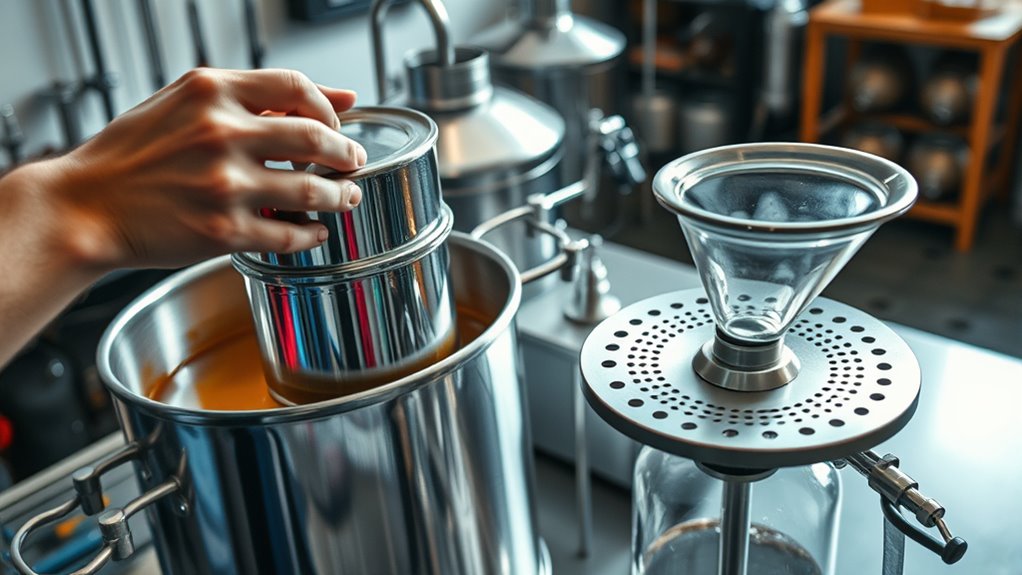
Getting started with brewing coffee at home requires a few essential pieces of equipment to guarantee a smooth and satisfying experience. First, you’ll need a good grinder because grind size directly impacts extraction; a consistent grind produces better flavor. Second, invest in a reliable kettle with temperature control to ensure water is at the ideal temperature, typically between 195°F and 205°F, for perfect extraction. Third, choose a brewing vessel suitable for immersion, like a French press or a pour-over cone, which allows you to control steeping time and water contact. These tools help you manage key variables like grind size and water temperature, giving you better control over your first brew and setting a strong foundation for enjoying great coffee at home. Additionally, understanding AI in Business can help you optimize your brewing process through smart appliances and data-driven techniques.
Step-by-Step Guide to Immersion Coffee Preparation
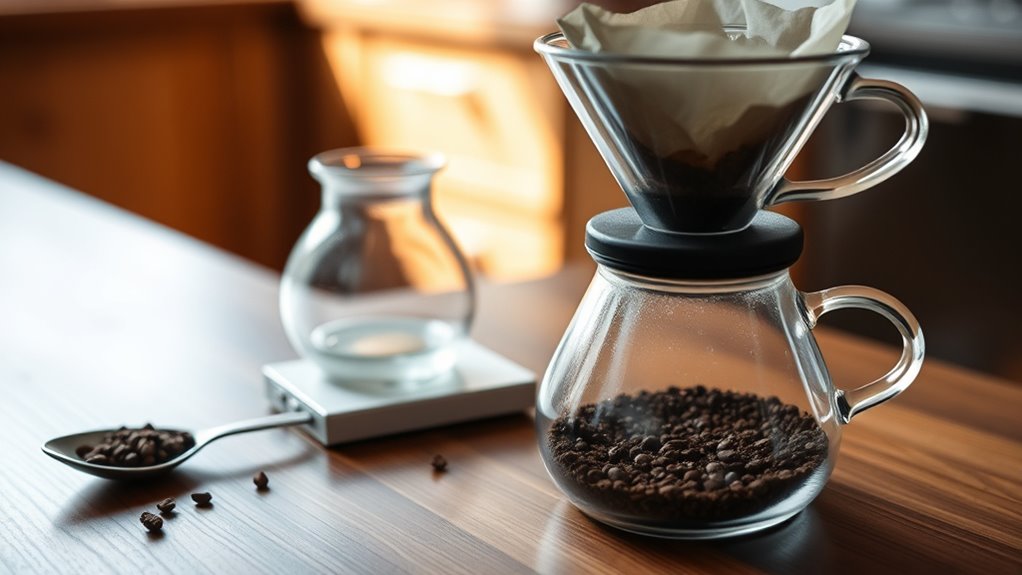
To start your immersion coffee process, begin by measuring the desired amount of coffee grounds and placing them directly into your brewing vessel, such as a French press or dedicated immersion brewer. Choose coffee beans based on your preferred origin, as different regions impart unique flavors. Next, heat your water to the ideal brewing temperature, typically around 195-205°F, ensuring extraction without overdoing it. Pour water evenly over the grounds, saturating them completely. Stir gently to promote even extraction, then place the lid on your vessel. Let the coffee steep for about four minutes, adjusting time based on your taste. Once steeped, press the plunger down slowly, separating grounds from the brew. Serve immediately for fresh, full-bodied flavor rooted in the bean’s origin.
Mastering the Percolation Process for Optimal Flavor
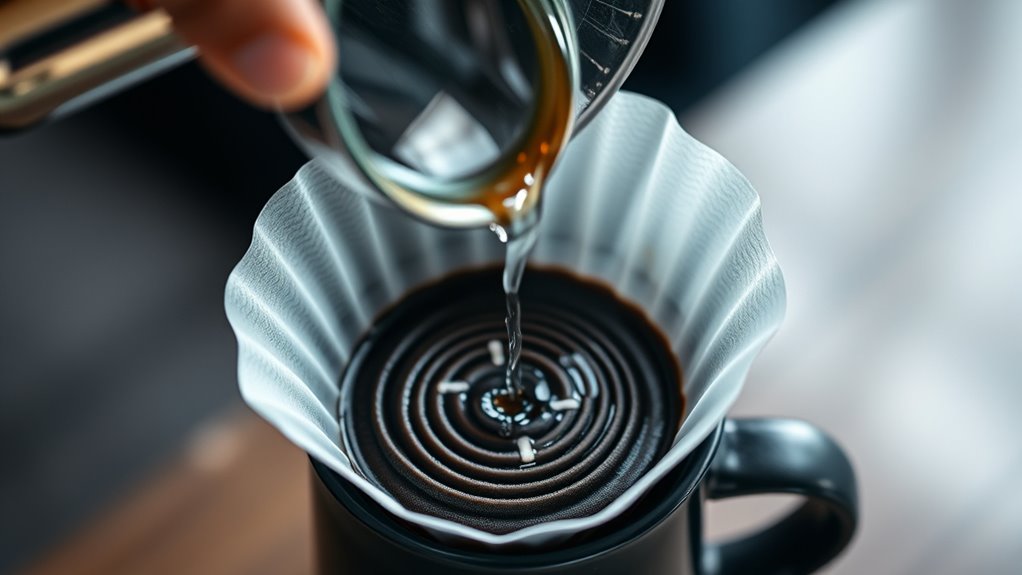
Mastering the percolation process begins with selecting the right grind size—medium to coarse—to allow water to flow evenly through the coffee grounds. This is vital in brewing science, as grind size directly impacts extraction and flavor development. Understanding coffee chemistry helps you optimize extraction by controlling variables like flow rate and contact time. To perfect your method:
- Monitor water temperature to guarantee consistent extraction without scalding the coffee.
- Adjust grind size if the brew’s flavor is weak or over-extracted, balancing clarity and body.
- Use clean equipment to avoid stale flavors that can interfere with proper brewing science.
- Paying attention to water quality can significantly influence the final flavor profile and extraction efficiency.
Comparing Results: Flavor, Aroma, and Texture
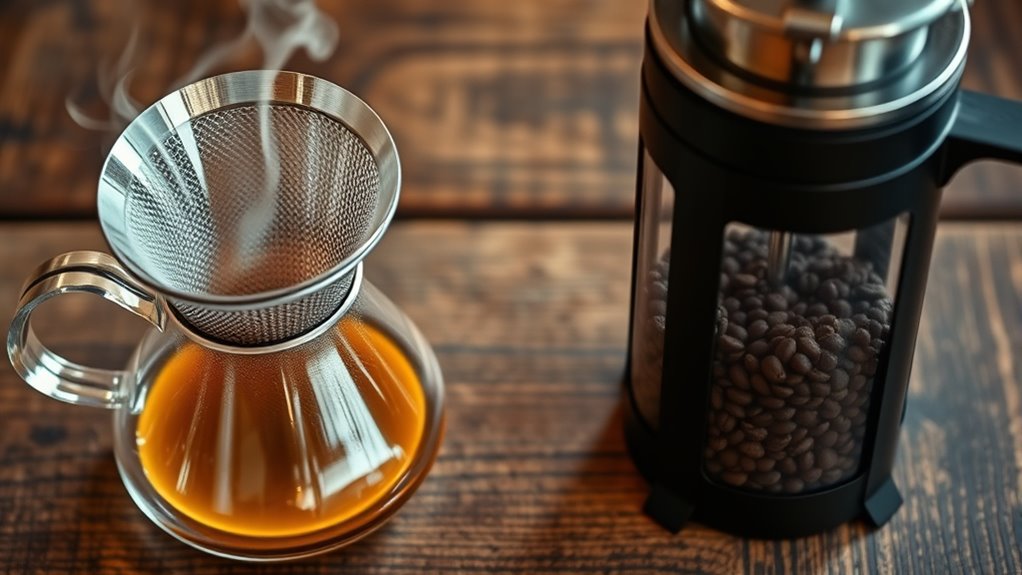
When comparing the results of immersion and percolation brewing methods, you’ll notice distinct differences in flavor, aroma, and texture. Immersion often highlights bean freshness, producing a fuller, more complex flavor profile with a richer aroma. It allows the beans to steep evenly at a consistent brew temperature, which preserves delicate aromatic compounds. Percolation, on the other hand, tends to extract sharper, brighter flavors with a cleaner finish. The brewing process’s shorter contact time emphasizes different notes, and temperature control plays a vital role in preventing over-extraction. Overall, immersion yields a smoother, more balanced cup, while percolation offers a brighter, more vibrant experience. Understanding these nuances helps you choose the method that best suits your taste preferences. Additionally, incorporating precise temperature control can significantly influence the extraction process, ensuring optimal flavor development for both methods.
Tips for Troubleshooting and Perfecting Your Brew

If your brewed coffee doesn’t quite match the flavor or aroma you expected, small adjustments can make a big difference. First, tweak your grind size—finer grinds increase extraction, while coarser ones reduce bitterness. Second, check your water temperature; ideally, it should be between 195°F and 205°F to optimize flavor extraction. Third, consider your brewing time—longer extraction can deepen flavor but risks over-extraction. To troubleshoot: 1. Adjust the grind size based on your brew’s strength and clarity. 2. Use a thermometer to guarantee water stays within the ideal temperature range. 3. Experiment with brewing time to find the sweet spot for your preferred taste. Understanding personality traits can also help refine your brewing style and adapt to different coffee preferences. These small tweaks can help you refine your method and consistently produce a perfect cup.
Frequently Asked Questions
What Are the Environmental Impacts of Immersion Versus Percolation Brewing?
You can minimize environmental impacts by choosing immersion brewing, which typically uses less water and promotes eco-friendly practices. Percolation methods often require more water and energy, increasing their environmental footprint. To reduce your impact, focus on water conservation and eco-conscious choices, like using reusable filters or sustainable beans. By being mindful of your brewing method, you help protect resources and support sustainable coffee consumption.
How Do Brewing Times Influence Flavor Extraction in Both Methods?
Ever wonder how brew time impacts flavor extraction? Longer brewing times generally lead to more thorough flavor extraction in both immersion and percolation methods, but the effects vary. Immersion brewing benefits from extended contact, enhancing richness and complexity, while percolation’s faster flow can produce a brighter, more vibrant taste if you don’t over-extract. Adjust your brew time based on desired flavor profile to achieve the perfect cup.
Can These Methods Be Effectively Combined for a Customized Brew?
Yes, you can effectively combine these brew methods for flavor customization and achieve a unique brew method synergy. Try starting with immersion to extract rich flavors, then switch to percolation for clarity and added complexity. This approach lets you tailor your coffee profile, balancing strength and smoothness. Experimenting with timing and technique allows you to create a personalized brew that highlights the best of both methods.
What Are Common Mistakes That Beginners Make With Each Brewing Style?
You often struggle with brewing consistency and equipment maintenance, which are common beginner mistakes. With immersion brewing, you might over-steep or under-steep, affecting flavor. In percolation, you may not monitor the grind size or timing, leading to over-extraction or weak brew. Regularly cleaning and maintaining your equipment helps prevent buildup, ensuring each brew is consistent. Pay attention to timing and cleanliness to improve your coffee experience considerably.
How Does Grind Size Affect the Success of Immersion and Percolation Brewing?
Did you know that grind size considerably impacts brewing success? For immersion brewing, a consistent, medium grind guarantees proper extraction, preventing over- or under-extraction. In percolation, particle size matters more; a coarser grind allows water to flow freely, avoiding over-extraction. Poor grind consistency or mismatched particle size can lead to weak or bitter coffee. Pay attention to your grind, tailoring it to your brewing style for maximum flavor every time.
Conclusion
Think of brewing coffee like tending a garden—you choose your method, nurture it, and wait to see the blooms. Whether you prefer the steady growth of immersion or the vibrant burst of percolation, each technique shapes your coffee’s character. With patience and practice, you’ll cultivate a rich, flavorful brew that delights your senses. So, pick your path, stay attentive, and watch your coffee garden flourish into a perfect cup every time.
